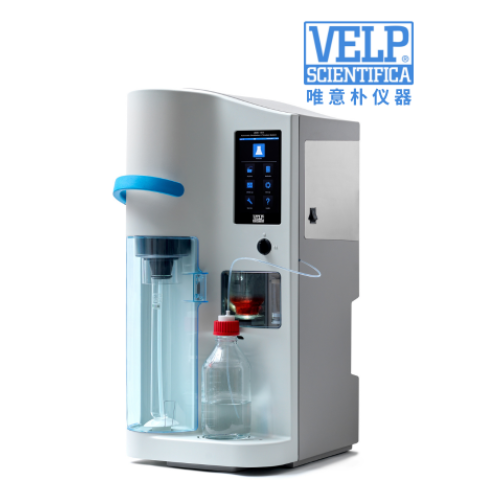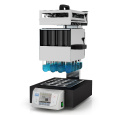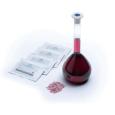方案详情
文
酪蛋白是一种含磷钙的结合蛋白,是哺乳动物包括母牛,羊和人奶中的主要蛋白质,又称:干酪素、酪朊、乳酪素。
α-酪蛋白是哺乳动物的主要蛋白,人乳中没有α-酪蛋白,以β-酪蛋白为主要酪蛋白形式。酪蛋白对幼儿既是氨基酸的来源,也是钙和磷的来源,酪蛋白在胃中形成凝乳以便消化。[
方案详情

APPLICATION NOTEF&F-K-006-2013/A1 CASEIN DETERMINATION IN MILKKJELDAHL METHOD Casein Determination in Milkaccording to the Kjeldahl method Reference: AOAC 998.05 Non-casein Nitrogen Content of Milk; AOAC 991.20 Nitrogen (Total) in Milk;ISO 8968-4FIL 20-4: 2001 Non-protein Nitrogen content Tested with VELP Scientifica DKL 20 Automatic Kjeldahl Digestion Unit (Code S30100210) andUDK 159 Automatic Kjeldahl Distillation & Titration System (Code F30200150). Introduction The milk proteins are the oldest and most widely consumed food proteins. There is currently a large interest in thesesubstances, both in nutritional field and in technological application. Casein proteins are a family of proteins involved in theproduction of cheese and fermented milk. They are very important nitrogen compounds not only for the dairy productsproduction, but they are also additives in medicine, and they have a technical use in cosmetics, paints and adhesives. Caseincontent is determined by the difference between the total nitrogen (Ntot) content and the non-casein nitrogen (NCN), obtainedby the milk, following the procedure indicated in this document. Casein Determination in milk according to the Kjeldahl method Kjeldahl is nowadays the most used method for determining nitrogen and protein contents in foods and feeds, thanks to the highlevel of precision and reproducibility and to its simple application. The modern Kjeldahl method consists in a procedure ofcatalytically supported mineralization of organic material in a boiling mixture of sulphuric acid and sulphate salt at digestiontemperatures higher than 400 C. During the process the organically bonded nitrogen is converted into ammonium sulphate.Alkalizing the digested solution liberates ammonia which is quantitatively steam distilled and determined by titration. Sample Liquid bovine high quality milk, whole and pasteurized Protein labeled value: 3.35 g/100 ml Casein content from literature: 2.66% Sample preparation The determination of the non-casein nitrogen (NCN) is necessary to calculate the casein content in the milk The NCN is obtained separating and filtrating the milk. Chemicals and Materials for separating and filtrating .Acetic acid solution 10%- 10 ml acetic acid diluted to 100 ml with deionized water . Sodium acetate solution 1M -8,2 g sodium acetate diluted to 100 ml with deionized water Filter paper nitrogen free, high speed filtration Procedure The determination of NCN in milk includes the following steps: -Stir the milk into a beaker using a VELP magnetic stirrer for 60 sec. at 700 rpm. - Precipitation of the casein and filtration -Digestion of the filtrate using DKL 20 -Distillation and titration of the sample using UDK 159 -Calculation (see the following formulas) Place 20 ml of milk, previously thermostated at 20 C, in a 50 ml volumetric flask with 20 ml of deionized water. Then,put the flask at 37 °C in an Open Circulating Bath (OCB, Code F40300240) for 30 minutes. After this period, add 2 ml ofacetic acid solution (10%), swirl to mix and let stand for approximately 10 minutes. Add 2 ml of sodium acetate solution1M, let the mixture cool down to 20 °C and fill up with deionized water to the calibration mark. Then, filter through a filterpaper and collect the entire filtrate. Sample Digestion Put 20 ml of filtrate into a 250 ml test tube (Code A00000144), by using a pipette In each the test tube add: ● 2 catalyst tablets CM (code CT0006650;3.5g K2SO4,0.1 g CuSO4 5H20 Missouri) 4 antifoam tablets S (Code CT0006600) 15 ml concentrated sulphuric acid (96-98%) 5 ml of hydrogen peroxide (~30%) Prepare some blanks with all chemicals and without sample. VELP Scientifica,Italy Tel: +39 039628 811 Fax: +39 039 628 8120 www.velp.com Connect the Digestion Unit to a proper Aspiration Pump (JP code F30620198) and a Fume Neutralization System(SMS Scrubber code F307C0199) to neutralize the acid fumes created during digestion phase. Digest the samples,setting the following ramps in “Customizable Methods": for 15 minutes at 150°℃ plus 45 minutes at200°C plus 15 minutes at 300°C plus 60 minutes at 420°C Distillation and Titration Let the test tubes cool down to 50-60 °C. Condition the UDK 159 unit by performing the Automatic Check up in Menu-System and a Wash down. Distill the samples selecting the predefined method n°1: ● H2O (dilution water): 50 ml NaOH (32%): 70 ml H3BO3 (4% with indicators):30 ml H2SO4 (0.1 N) as titrant solution Protein factor: 6.38 In UDK 159 settings, set as unit of measure mgN and %N for the final result and as sample quantity“ml". Distillation &Titration analysis time: from 4 minutes for one test. Typical Results The results of the non-casein nitrogen (NCN) are calculated as percentage of nitrogen, using as sample quantity thevolume of filtrate (V filtrate) multiplied for 0,4. They are based on the following formula: G milk = milk weight (20 g) V sol= milk solution containing all the chemicals necessary for separating, filled up to volume (50 ml)V filtrate= filtrate used to perform 1 analysis (ml) The obtained results have been exported and multiplied for the whole milk correction factor 0.994 (for semi skimmedmilk, the correction factor is 0.998). Casein is calculated taking into account the measured total nitrogen content (Ntot) of0.525% in whole milk. (For Ntot, see Application Note“N/Protein Determination in Milk according to the Kjeldahl method") Casein%=6.38x(%Ntot-%NCN) Filtrate quantity (ml) NCN%* Casein% 20.000 0.108 2.658 20.000 0.109 2.653 20.000 0.110 2.646 Average ±SD% 0.109±0.001 2.652±0.006 RSD%** 0.923 0.243 ' already corrected with 0,994 factor **RSD%= (Standard Deviation x 100) / Average The complete procedure was verified by using 5 ml of glycine standard solution (3%) containing 28 mg of nitrogen, asreference substance. The obtained recovery falls into the expected range: between 98% and 102%. Conclusion The obtained results are reliable and reproducible in accordance with the expected values, with a low relative standarddeviation (RSD <1%), that means high repeatability of the results. Benefits of Kjeldahl method by using DKL 20 and UDK 159 are: High level of precision and reproducibility Time saving High productivityAffordable equipment costWorldwide official methodModerate running costs Reliable and easy method Copyright C VELP Scientifica. All rights reserved.No part of this publication may be reproduced or transmitted in any form or for any purpose without the express permission of VELP.VELP Scientifica, Italy Tel: + Fax: + www.velp.com 本文利用凯氏定氮方法对牛奶当中的酪蛋白进行测定。
确定
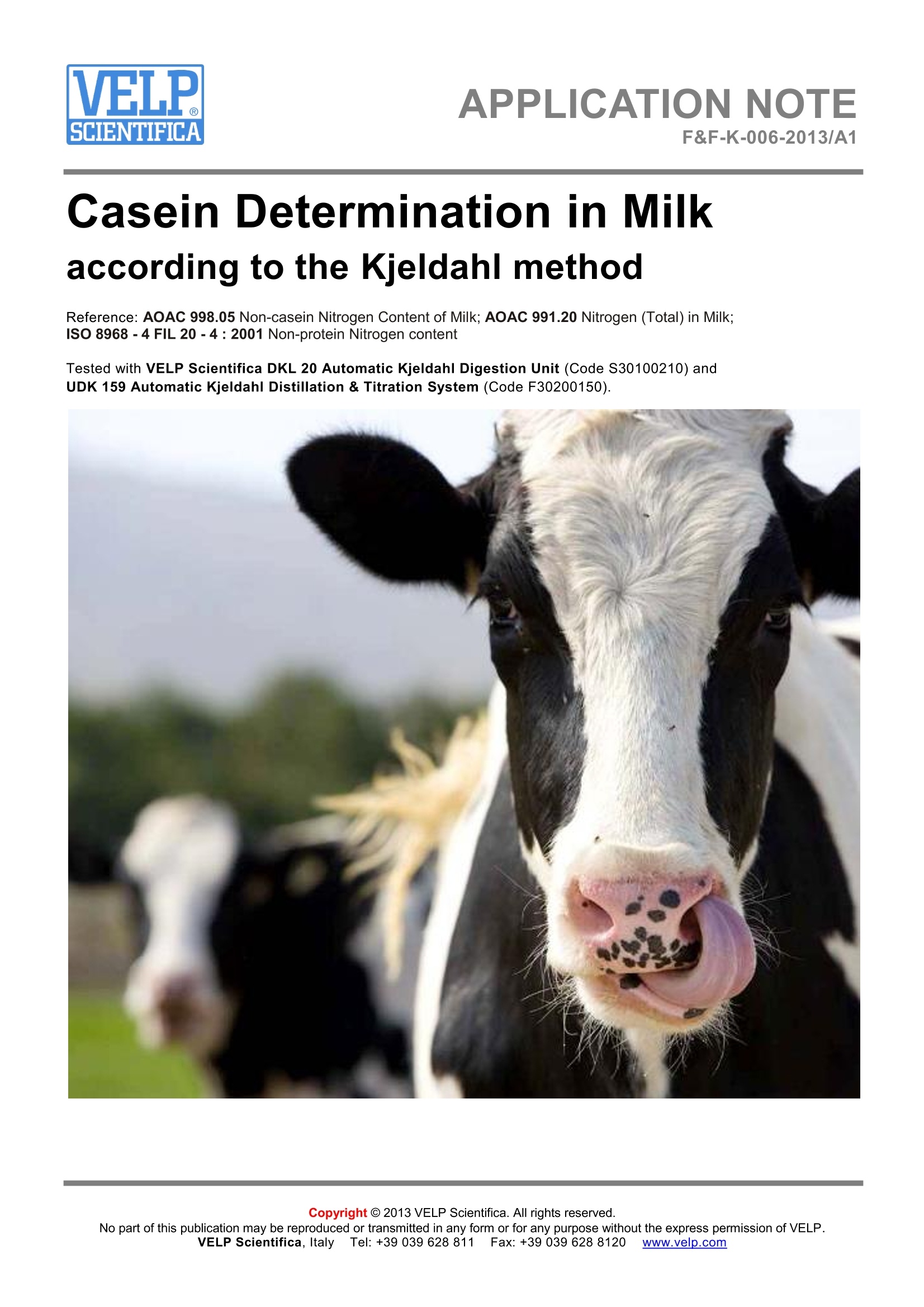

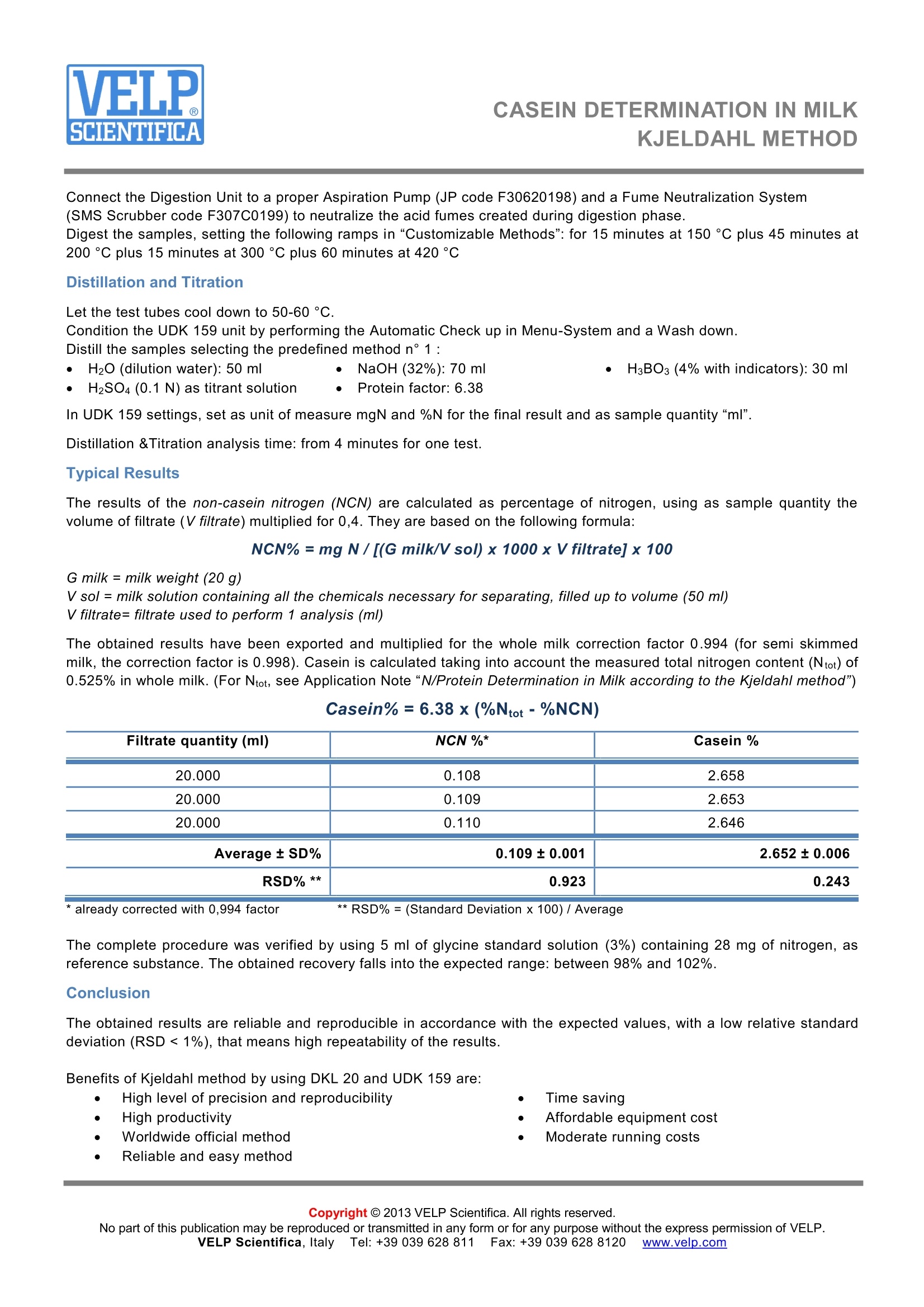
还剩1页未读,是否继续阅读?
意大利VELP公司为您提供《牛奶中酪蛋白检测方案(定氮仪)》,该方案主要用于液体乳中营养成分检测,参考标准《GB 5009.5-2010 食品中蛋白质的测定》,《牛奶中酪蛋白检测方案(定氮仪)》用到的仪器有VELP唯意朴仪器 全自动凯氏定氮仪UDK 159 、VELP DKL 20 全自动消化炉、VELP V-Receiver 硼酸粉
相关方案
更多
该厂商其他方案
更多

